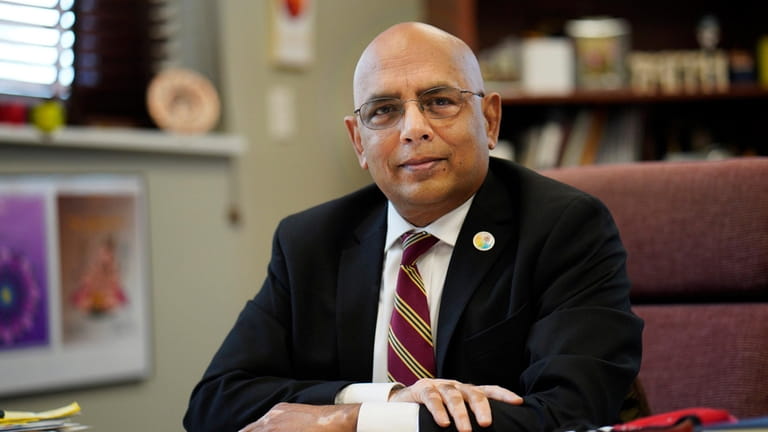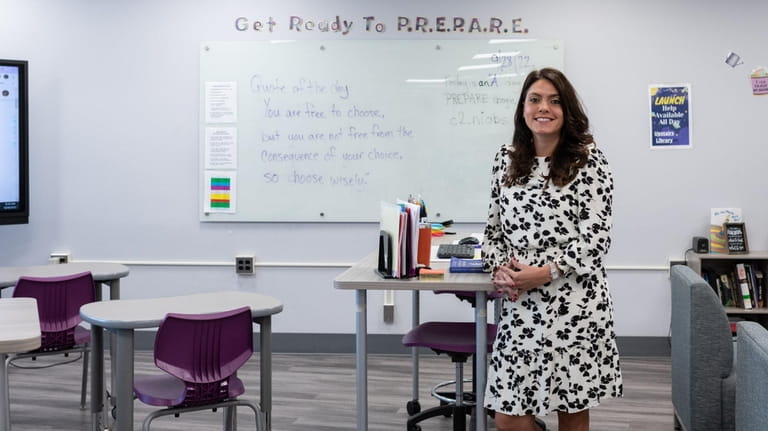LI school districts are to get $500M in federal COVID-recovery aid over three years. Here's how they plan to spend it.

Long Island school districts have earmarked more than a half-billion dollars in federal pandemic-recovery money for initiatives ranging from math tutoring to psychological counseling to installation of air ventilation systems, state records show.
A Newsday review of reports filed by local districts found that more than $200 million in COVID-19 relief aid will be spent during the current school year, with an additional $175 million scheduled for 2023-24. Nearly $149 million was spent in 2021-22, reports indicated.
Newsday's analysis of financial data collected by the state Department of Education covered 54 districts in Nassau County and 58 in Suffolk, along with the Little Flower School in Wading River, which is independent and serves children with special needs. The department noted on its website that Amityville's report, though required, had not been submitted as of Friday.
Funding comes from the American Rescue Plan Act, which was signed into law by President Joe Biden in 2021 and is distributed by a formula that factors in enrollment size and family income levels. The top five recipients in this region are the Brentwood district, with $92.8 million over three years; Hempstead, $35.6 million; Central Islip, $29 million; Freeport, $21.4 million; and Roosevelt, $21.3 million.
WHAT TO KNOW
- Long Island schools have designated more than $500 million in federal pandemic-relief money for spending over a three-year period, including more than $200 million for the current school year.
- Top recipient districts for federal aid money in this region are Brentwood, with $92.8 million over three years; Hempstead, $35.6 million; Central Islip, $29 million; Freeport, $21.4 million and Roosevelt, $21.3 million.
- Finance experts say most aid money is directed at three goals: repairing student learning loss, supporting students with emotional and psychological ills, and upgrading school facilities including ventilation systems.
Packed with details, district reports present a new overview of how federal money is being used.
"School districts are still finding their footing after two-and-a-half years of the pandemic," said Robert Schneider, executive director the New York State School Boards Association.
Schneider, whose group did a statewide analysis of federal funding, concluded that American Rescue Plan Act money, combined with other federal and state aid, "will go a long way toward addressing many of the unintended consequences brought on by school closures and remote learning."
Ryan Ruf, chief operating officer of the regional Eastern Suffolk BOCES, summed up spending plans on the Island as focused largely on three priorities: (1) repairing student learning loss, (2) providing emotional and psychological support, and (3) renovating school buildings with improved filtration of heating and cooling systems.
How some districts plan to spend
A sampler of district spending priorities on the Island:
Brentwood — The district's plan sets specific goals for raising the numbers of students scoring proficiently on English and math tests in grades 3-8. The plan also calls for higher rates of test participation. To accomplish this, the district is prioritizing such approaches as extended school days and Saturday instruction. Brentwood's plan also includes installation of charging stations for students' laptop computers.
Kevin Coyne, president of Brentwood's 1,400-member teacher union, said the federal rescue plan "has really helped us come up with ways in which we can try and meet the learning loss in our school districts."

Freeport schools Superintendent Kishore Kuncham is wary of the bite that inflationary costs might take. Credit: Chris Ware
Freeport — The district's plan includes use of new curriculum materials and Saturday academies to help struggling students catch up with lessons. The district also has budgeted $120,000 to help teens pay for testing in college-level Advanced Placement courses. On the facilities side, Freeport has placed a priority on upgraded ventilation systems for nurses' offices, auditoriums and cafeterias.
"A shot in the arm" is how Kishore Kuncham, the district's superintendent, described federal assistance. Kuncham noted, however, that inflationary costs are cutting into the value of that aid, and that "it's going to take time" for districts to contract for building renovations.
Patchogue-Medford — Under the district's plan, groups of about 10 students each met regularly for tutoring in English and math. The small classes, which began last summer, have continued into the current school year for students who are two years below grade level.
Standardized tests are administered periodically to measure students' progress and help staffers decide if the tutored students have progressed enough to be returned to regular classes. Another initiative, funded through state aid, is a mental health screening system used for identifying students at risk and providing help when needed.
Donna Jones, the district's superintendent, described federal money as "super helpful." She noted that such money will eventually run out, adding, "I ask myself: How will I sustain the things I know are good for children?"
Farmingdale — At the district's high school, unused library space and two classrooms have been converted into a "wellness" center, well lit and with a sunrise mural decorating one wall. Here, students can obtain tutoring assistance with coursework and counseling on personal problems, or simply relax between classes.

Instructor Lauryn Schmettan at Farmingdale High School. There, library space and two classrooms have been converted into a "wellness" center. Credit: Dawn McCormick
The center is staffed by four full-time professionals, as well as by 10 to 20 teachers who come in part time to help tutor. The center is supported with federal funds, though its origins predate the pandemic. Staffers who helped organize the center include an assistant principal, Jed Herman, and an English teacher, Diana Rossi.
"We have this place, a safe space where we can just talk," said Amya Johnson, 17, a senior at Farmingdale High who visits the center regularly. "Our social workers are always ready to talk to us."
Paul Defendini, the district's superintendent, said the center's staff works with students who have behavioral problems, to prevent infractions from escalating and causing students to be suspended from classes. In addition, staffers use a program developed at Yale University to help teens deal with emotional stress and develop positive attitudes.
"Punishments weren't having their intended effect, they weren't providing the sort of support structures that students truly needed," said Defendini, in explaining part of the rationale behind creating the center. "It became apparent to us that we needed to investigate different ways of doing things."
Eight priority areas identified
Across Long Island and the state, the newly filed district reports follow a state format. This lists eight priority areas and asks districts to designate which priorities they are pursuing and how much federal money will be invested in each area.
On the Island, the top-listed priority area was "addressing the impacts of the COVID-19 pandemic on students." It accounted for 26.4% of all federal money budgeted over three years, Newsday found.
No. 2 on the list was "safely returning students to in-person instruction," accounting for 14.8% of funding. Nos. 3 and 4 were "offering extended learning and enrichment programs" and "implementing strategies to meet students' needs" at 12.9% and 12.1%, respectively.
Collection of district reports represents a stepped-up effort to track use of federal dollars. In the early days of the pandemic, there were widespread complaints from financial experts at both national and state levels that accounting was lax.
"I do think the public has a right to know how it was spent," said Roger Tilles of Manhasset, who represents Long Island on the state's Board of Regents.
The Regents board sets much of the state's educational policy.
By federal law, districts are supposed to commit to using whatever remains of American Rescue Plan Act money by Sept. 30, 2024. Funds then are to be spent within the next 120 days.
Some skeptics have questioned what will happen when districts run out of time, money or both. One answer is that districts also can draw on state aid, which has risen at record levels for this year and last year and is scheduled to increase again in 2023-24. However, the exact level of future funding will not be known until a new state budget is adopted in April.
Robert Lowry, deputy director of the New York State Council of School Superintendents, noted in a message to Newsday that an economic recession, should it occur, could cause state revenues to drop and imperil the state's ability to fully fund school aid. He added, however, that there were mitigating circumstances.
"A positive aspect is that the state starts from a stronger position than typical of the recent past, with high levels of 'rainy day' funds and low projected deficits right now," Lowry wrote.
